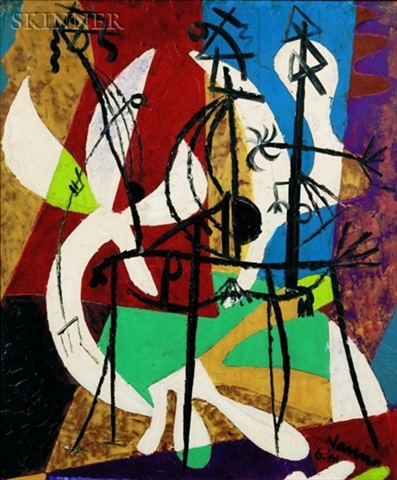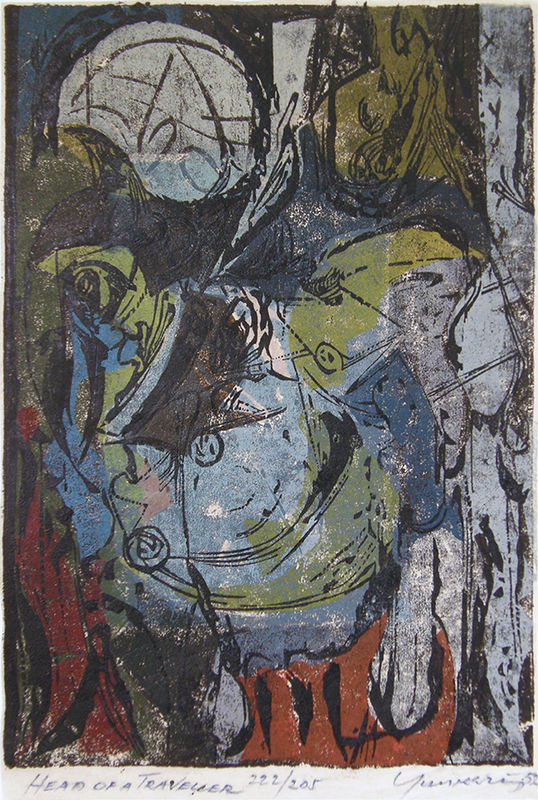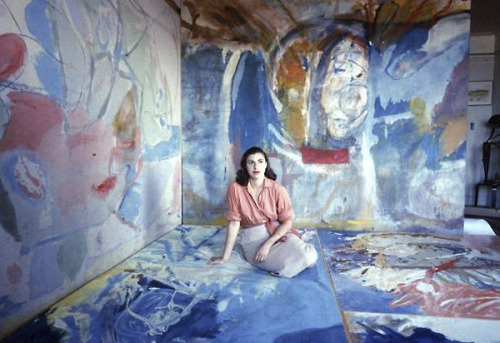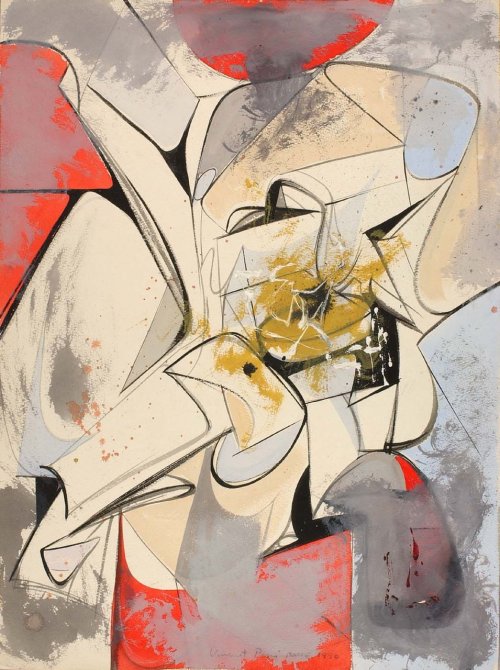From Wikipedia: Six months after her death, the Museum of Modern Art (MoMA) in New York City held a retrospective exhibition of her work. A review of the exhibition in the New York Times noted that it "clearly defines Krasner's place in the New York School..." and that she "is a major, independent artist of the pioneer Abstract Expressionist generation, whose stirring work ranks high among that produced here in the last half-century." As of 2008, Krasner is one of only four women artists to have had a retrospective show at the Museum of Modern Art. The other three women artists are Louise Bourgeois (MoMA retrospective in 1982), Helen Frankenthaler (MoMA retrospective in 1989) and Elizabeth Murray (MoMA retrospective in 2004).
An appreciation blog for abstract art, in particular from the abstract expressionist school. Pollock, de Kooning, Hofmann, Frankenthaler, Riopelle, Gorky, et al. will be presented here. All rights reserved by the artists or their legal delegates.
Thursday, June 30, 2011
Wednesday, June 29, 2011
John Altoon - Fay's Christmas Painting, 1958
From Wikipedia: Altoon's work was related to Abstract expressionism although he is best known for his figurative works of the 1960s, with as Leah Ollman describes "a vocabulary of vaguely figurative, botanical and biological forms that he pursued until his death." He was part of the "Ferus group" of artists so called for their association to the Ferus Gallery that operated in Los Angeles in 1957–1966. Some of the others artists included in this group are Edward Kienholz and Robert Irwin.
Tuesday, June 28, 2011
Elaine de Kooning - Sunday Afternoon, 1957
From Russell McNeil's blog: An active participant in the downtown scene of East Tenth Street, The Club and the Cedar Street Tavern, Elaine Fried de Kooning helped champion an approach to Abstract Expressionism which emphasized the physical... presence and dynamism of the human figure through strong, gestural brushwork. In contrast to her husband's interest in painting female figures--for which she was frequently both model and muse--she concentrated on depicting men in her art. An unabashed admirer of masculinity, de Kooning created portraits of her husband and friends such as painter Fairfield Porter, poet Frank O'Hara and dancer Merce Cunningham. "I became fascinated by the way men's clothes divide them in half--the shirt, the jacket, the tie, the trousers. Some men sit all closed up--legs crossed, arms folded across the chest. Others are wide open. I was interested in the gesture of the body--the expression of character through the structure of clothing."
Monday, June 27, 2011
Herman Cherry - Untitled, 1959
From the Parrish Art Museum site: "The painter Herman Cherry began spending summers in East Hampton in 1964 and maintained a residence there until his death in 1992. He studied with Thomas Hart Benton around 1930, and his early work reflects an interest in American Regionalism, Mexican mural painting, and Chinese art. In 1945, after years of travel, he settled in New York, and by the 1950s his work had become abstract. Cherry was known for his skillful interplay of color and shape, and he painted in this vein for the rest of his career."
Saturday, June 25, 2011
Willem de Kooning - Asheville, 1948
An interesting article that analyzes this painting: http://www.martinries.com/article2005DK.htm . In part:
De Kooning admired Cubism for its emphasis on structure; yet Asheville, (1948, Phillips Collection, Washington, D.C.) its surface sensuality dominating compositional logic, is both linear and painterly as well as structural. The need for the ordered geometric background structure of Cubism did not begin to disappear from de Kooning's work until he increased his gestural activity, probably under Jackson Pollock's influence, by loosening shapes and allowing the paint to run in such paintings as Light in August.
Joseph Stefanelli - Dictum, 1962
From Wikipedia: "He had his studio in the Lower East Side, on 22nd Street. Stefanelli soon joined the "Downtown Group" which represented a group of artists who found studios in lower Manhattan. Franz Kline introduced Stefanelli to 'The Artists’ Club’ located at 39 East 8th Street. Joe Stefanelli was chosen by his fellow artists to show in the Ninth Street Show held on May 21-June 10, 1951. The show was located at 60 East 9th Street on the first floor and the basement of a building which was about to be demolished: "The artists celebrated not only the appearance of the dealers, collectors and museum people on the 9th Street, and the consequent exposure of their work but they celebrated the creation and the strength of a living community of significant dimensions."
Joe Stefanelli participated in 1951 and from 1954 to 1957 in the invitational New York Painting and Sculpture Annuals including the Ninth Street Show. These Annuals were important because the participants were chosen by the artists themselves."
Thursday, June 23, 2011
Nanno De Groot - Abstract, 1950
From the Province Town Art Registry site: "Born in Holland in 1913, Nanno de Groot moved to New York in 1948, where he came to identify with abstract expressionists such as Jackson Pollock, Hans Hofmann, Franz Kline and Joan Mitchell. His earlier works included a number of monotypes and the now famous "Linear Figures" series, skeletal characters delineated by evocative streaks of black oil paint."
Wednesday, June 22, 2011
Arshile Gorky - The Liver in the Cock's Comb, 1944
From Wikipedia: When Gorky showed his new work to André Breton in the 1940s, after seeing the new paintings and in particular The Liver is the Cock's Comb, Breton declared the painting to be "one of the most important paintings made in America" and he stated that Gorky was a Surrealist, which was Breton's highest compliment. The painting was shown in the Surrealists' final show at the Galerie Maeght in Paris in 1947.
Michael Auping, a curator at the Modern Art Museum in Fort Worth, saw in the work a "taut sexual drama" combined with nostalgic allusions to Gorky's Armenian past. The work in 1944 shows his emergence in the 1940s from the influence of Cézanne and Picasso into his own style, and is perhaps his greatest work. It is over six feet high and eight feet wide, depicting "an abstract landscape filled with watery plumes of semi-transparent color that coalesce around spiky, thornlike shapes, painted in thin, sharp black lines, as if to suggest beaks and claws."
Tuesday, June 21, 2011
Adja Yunkers - Head of a Traveler, 1952
From Wikipedia: "Adja Yunkers (1900–1983) was an abstract painter and printmaker who was born in Riga, Latvia, in 1900. He studied art in Leningrad, Berlin, Paris, and London. He lived in Paris for 14 years, and then moved to Stockholm in ...1939. In Stockholm, he published and edited the arts magazines ARS magazine and Creation magazine. In 1947 he moved to the United States, where he lived for the rest of his life. In 1949, he received a Guggenheim Fellowship. During the 1950s he primarily worked in color woodcuts, introducing brushwork into the genre. In 1960, he began producing lithographs. He produced two important series of lithographs at the Tamarind Lithography Workshop in Los Angeles―Salt (five lithographs) and Skies of Venice (ten lithographs). Yunkers died in New York City in 1983."
Monday, June 20, 2011
Hans Hofmann - Color Poem No. 6, 1954
From hanshofmann.net: "In addition to his paintings, Hofmann’s continuing legacy includes not only those students who became accomplished artists, but also those who became teachers and mentors themselves, spreading Hofmann’s influence far... beyond even the large numbers he taught. Hofmann was recognized for helping students find their own distinctive ways to practice art. He never insisted that they become abstract artists; in fact, most of his students never saw his own paintings until after he had retired from teaching. Instead, he encouraged them to frequent museums and galleries, often exposing them to new styles of art. Former Hofmann students include : James Gahagan, Red Grooms, Lillian Orlowsky, Wolf Kahn, Paul Resika, Mercedes Matter, Irving Kershner, Roberd DeNiro Snr, Myrna Harrison and Frank Stella."
Sunday, June 19, 2011
Albert Kotin - Untitled, 1950
From Wikipedia: "After the war Albert Kotin found a studio on 10th Street. He soon joined the "Downtown Group" which represented a group of artists who found studios in lower Manhattan in the area bounded by 8th and 12th street between ...First and Sixth Avenues during the late 1940s and early 1950s. These artists were called the "Downtown Group" as opposed to the "Uptown Group" established during the war at The Art of This Century Gallery. In 1949 Albert Kotin joined the "Artists' Club" located at 39 East 8th Street. Albert Kotin was chosen by his fellow artists to show in the Ninth Street Show held on May 21-June 10, 1951. The show was located at 60 East 9th Street on the first floor and the basement of a building which was about to be demolished. "The artists celebrated not only the appearance of the dealers, collectors and museum people on the 9th Street, and the consequent exposure of their work but they celebrated the creation and the strength of a living community of significant dimensions."
Saturday, June 18, 2011
Joop Sanders - Return of the Prodigal, 1956
From Wikipedia: For Joop Sanders' 1960 exhibition at the Stedelijk Museum, critic Thomas B. Hess wrote the following.
"It was in 1948 that I first met the advanced painters and sculptors who a decade later were to become famous as the “New York School”. And it was then that I was introduced to Joop Sanders and I was told that Joop was painting in a new style. Later I saw his pictures in some of the huge lively exhibitions the artists themselves organized in empty lofts and stores (no one in New York with the exception of Pollock was selling any paintings). At the time Sanders was obviously influenced by de Kooning and as it turned out this influence was the healthiest, the most open and stimulating of the moment as many of Sanders’ young colleagues can testify. They went on to discover or invent some of the most original forms of the 1950s. Shortly thereafter Sanders went to Europe where, I heard, he was establishing a growing reputation."
Friday, June 17, 2011
Franz Kline - Black on Green Red and Yellow, 1948
From Wikipedia: "As with Jackson Pollock and other Abstract Expressionists, he was labeled an "action painter" because of his seemingly spontaneous and intense style, focusing less, or not at all, on figures or imagery, but on the actual br...ush strokes and use of canvas. For most of Kline's [mature and representative] work, however, as the phrase goes, "spontaneity is practiced". He would prepare many draft sketches – notably, commonly on refuse telephone book pages – before going to make his "spontaneous" work."
Thursday, June 16, 2011
Mary Abbott - Mr. Lee, 1950
After World War II Mary Abbott joined the "Downtown Group" which represented a group of artists who found studios in lower Manhattan. In 1946 she set up a studio on Tenth Street in Manhattan. Abbott, like many of her contemporaries found her way to the Hamptons in Long Island, New York. By 1950, she had a house and studio in Southampton as well as in downtown New York City. She soon found her way to important uptown New York City galleries.
Wednesday, June 15, 2011
Gordon Parks - Painter Helen Frankenthaler sitting amidst her art, 1956
From Wikipedia: Helen Frankenthaler (born December 12, 1928) is an American abstract expressionist painter. She is a major contributor to the history of postwar American painting. Having exhibited her work in six decades she has spanned several generations of abstract painters while continuing to produce vital and ever-changing new work. She began exhibiting her large-scale abstract expressionist paintings in contemporary museums and galleries in the early 1950s. She was included in the 1964 Post-Painterly Abstraction exhibition curated by Clement Greenberg that introduced a newer generation of abstract painting that came to be known as Color Field. Born in New York City, she was influenced by Hans Hofmann, Jackson Pollock's paintings and by Clement Greenberg. Her work has been the subject of several retrospective exhibitions; including a 1989 retrospective at the Museum of Modern Art in New York City. Her work has been exhibited worldwide since the 1950s. In 2001, she was awarded the National Medal of Arts.
Frankenthaler has a home and studio in Darien, Connecticut.
Tuesday, June 14, 2011
Vincent Pepi - #504 Abstraction, 1950
From Wikipedia: "Vincent Pepi studied at Cooper Union and Pratt Institute. He traveled to Africa and Mexico. In 1949 he went to Rome, Italy. This was the same time that the Abstract Expressionist movement began in New York City. Three years later, in 1951, Pepi joined with many of the innovators of Action Painting in New York City. Upon his return to the United States, Pepi studied briefly with Hans Hofmann. Along with other first generation abstract expressionists, he showed his work at the Stable Gallery in 1953 and at the March Gallery on Tenth Street, from 1955 until its closing in 1960."
Monday, June 13, 2011
Wassily Kandinsky - Composition VI, 1913
From Wikipedia: "Kandinsky's creation of purely abstract work followed a long period of development and maturation of intense theoretical thought based on his personal artistic experiences. He called this devotion to inner beauty, fervor of spirit, and deep spiritual desire inner necessity, which was a central aspect of his art."
Sunday, June 12, 2011
Welcome to Abstracted for Life!
I created this blog to share my favorite abstract artworks that I've seen or I am learning about as I traverse the interwebs. I've been posting an abstract work of art per day (leaving Sunday for my Van Gogh posts) on my Facebook wall for the last several months, saving them in Evernote in some logical fashion. Now it's time to branch out to Blogger.com.
I have a particular love for works from the abstract expressionist school, concentrating on pieces from Jackson Pollock, Willem de Kooning, Arshile Gorky, Hans Hoffman, Jean-Paul Riopelle, Joan Mitchell and others. Every once in a while, I'll post something from Vassily Kandinsky, another favorite, though of the earlier abstract school.
If you happen upon this blog, don't hesitate to comment! I love discussing this art form as much as I enjoy viewing it.
Thanks for reading.
Michael
I have a particular love for works from the abstract expressionist school, concentrating on pieces from Jackson Pollock, Willem de Kooning, Arshile Gorky, Hans Hoffman, Jean-Paul Riopelle, Joan Mitchell and others. Every once in a while, I'll post something from Vassily Kandinsky, another favorite, though of the earlier abstract school.
If you happen upon this blog, don't hesitate to comment! I love discussing this art form as much as I enjoy viewing it.
Thanks for reading.
Michael
Subscribe to:
Comments (Atom)
















